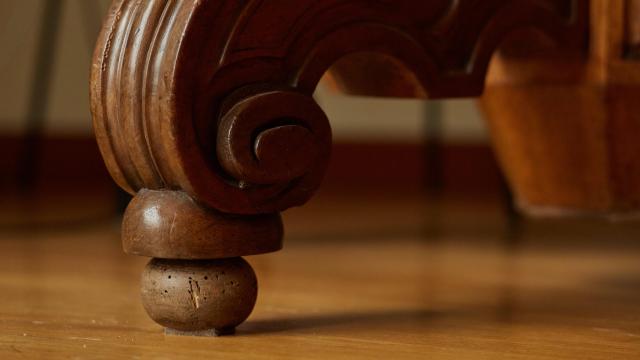Wobbly furniture can lead to all sorts of minor tragedies, from sloshed drinks to scratched floors — but you can make your furniture more stable with just the use of the humble hammer, screwdriver, and drill.
There are three main reasons that your furniture might be wobbly: Hardware holding the legs on can loosen up, the feet attached to the legs are missing, or the legs of your furniture aren’t sitting level against the floor. All of them are easily fixed.
First, tighten up your hardware
Look on the underside of your furniture piece near where it’s attached to the legs. Some furniture will have screws, bolts, or nuts of some kind that can be tightened, so use your screwdriver or wrench. If your furniture has legs that screw into the base, check to make sure that the legs are snug against it. If not, give the legs a turn or two. Place your piece back on its legs and see if that did the trick. If it did, then good job! If not, go ahead and read the next paragraph.
Next, check the feet
Check the bottom of the legs to see if there are nail-on, stick-on, or screw-in feet. If there are, check to see if any are missing. Sometimes these parts can fall off, causing the legs to sit unevenly on the floor, making your piece wobble.
If you discover that your furniture is missing one or more feet, it’s important to figure out which kind of feet they are. In most cases, it’s simpler to replace all the feet at the same time to ensure that they’re all the same size and shape.
There are a variety of types of feet, but the important thing is to get some that are the right type for your floors and furniture. You can determine the size by measuring the approximate diameter of the leg of your furniture. You’ll find this measurement on the packaging of most furniture feet at the hardware store.
The material of the feet should be marked on the package as well, including the type of floor the feet are meant for. Also, you’ll want to choose either a “non-slip” (rubber) or “easy glide” (tefflon) type of feet depending on whether you want to move your furniture frequently or not.
If there’s already hardware for screw-in feet, you can probably obtain replacement feet at your local hardware store. Often the best method for this is to unscrew one of the existing feet and bring it to the store to use as an example to make sure you get the right size and thread type. If your furniture is branded, an internet search for the brand and “levelling feet” might also be useful.
Replace damaged or missing pieces
Once you have obtained your hardware, you just need to attach it. If it’s stick on, make sure the bottoms of your piece’s legs are clean and dry, and then peel and stick. If you opt for the nail-on kind, turn your piece upside down and hammer the feet into the end of the legs with a lightweight hammer. If the feet screw in, choose a pilot bit that’s a little smaller than the screw on your foot, drill a pilot hole, and screw them in.
If your furniture already has screw-in, levelling feet and one or more is missing, you can skip the pilot hole and just screw in your replacement feet. Check to see if you’re wobble free. If you are, then your problem is solved. If not, there’s one more simple trick to use (and paragraph for you to read).
Last resort, add self-levelling feet
If your furniture is still wobbly, you might need to help level out the legs with some levelling hardware. There are lots of types of levelling feet on the market, but keep the same things in mind as with regular furniture feet: Size, floor type, and desired mobility are all the things to consider when choosing your hardware.
Levelling feet come in two pieces: a threaded insert that goes into the bottom of the leg of the furniture, and a foot that screws into it. To install the insert, select a drill bit that’s just a little smaller than the outside of the threaded piece. Drill a hole deep enough to accommodate your hardware in each leg of your furniture and then use a hammer to install the insert. Then you can screw in your feet.
Turn your piece right side up and check to see which way it tips when it wobbles. You can use the levelling feet to make minor adjustments to the legs of your furniture until you’ve eliminated the wobble. If that doesn’t work, you should check your floors or your house for ghosts.

Leave a Reply
You must be logged in to post a comment.